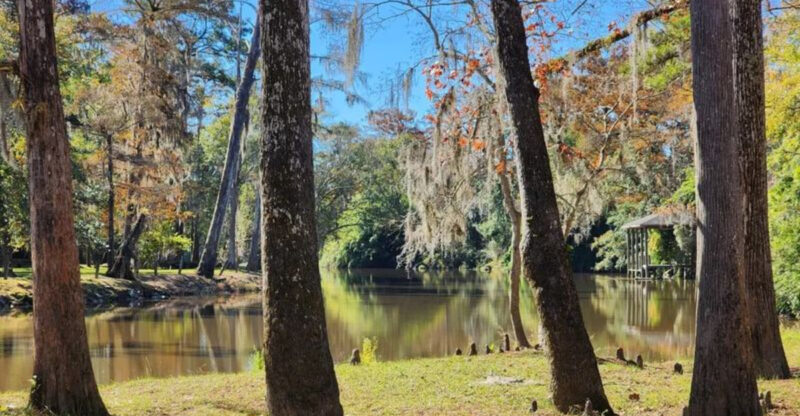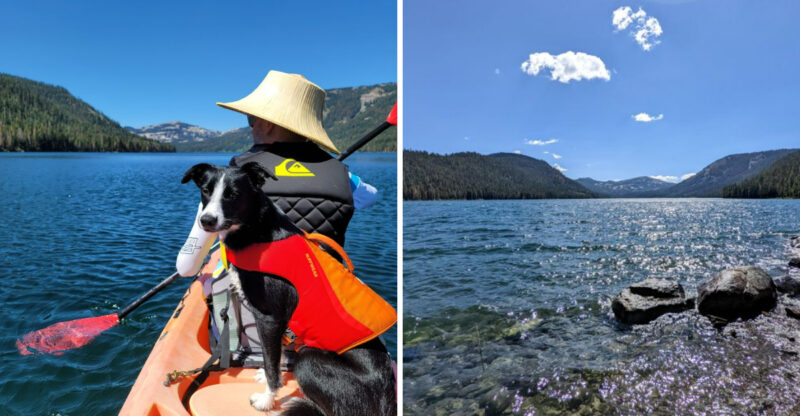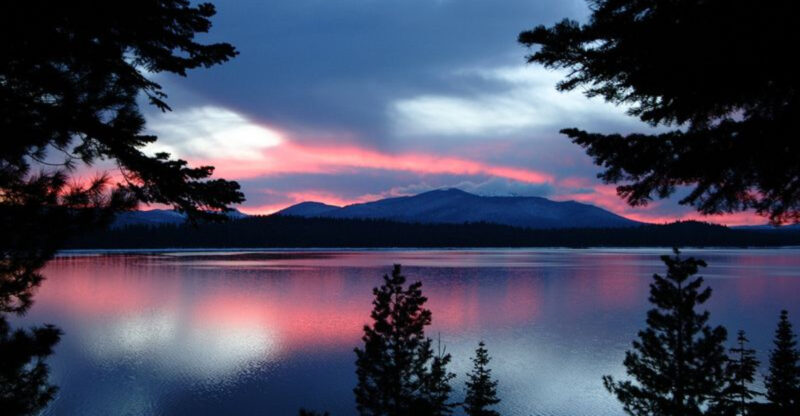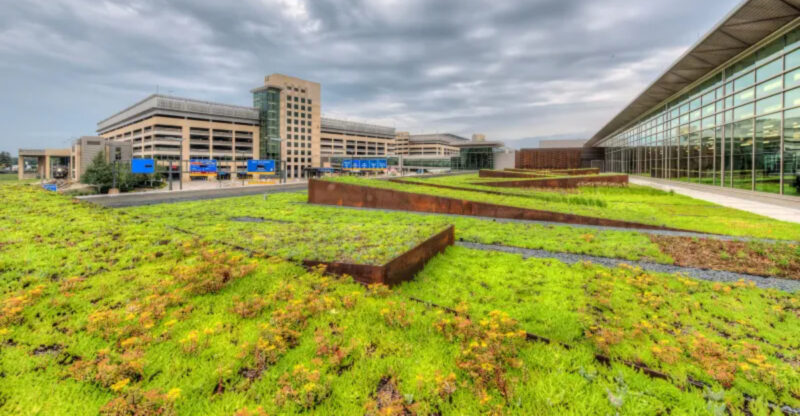Vermont Covered Bridges So Charming You’ll Want To Frame The View
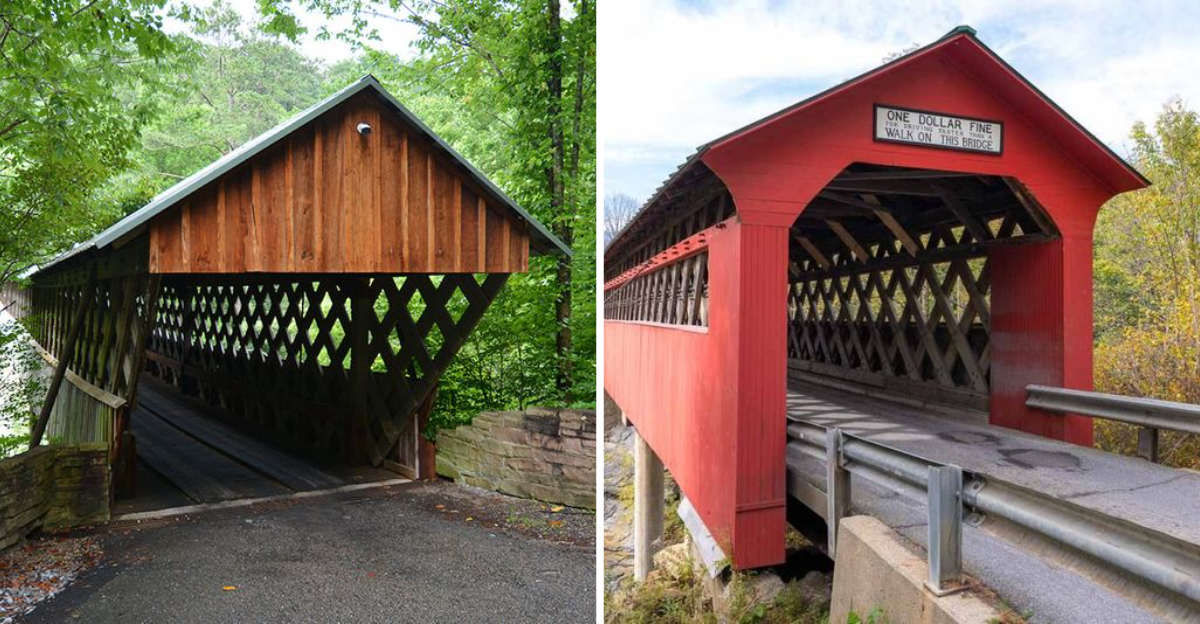
Vermont’s covered bridges stand as timeless monuments to American craftsmanship and rural beauty. These wooden treasures, many dating back to the 1800s, were originally built to protect bridge timbers from harsh New England weather.
Today, they offer photographers and travelers a perfect glimpse into Vermont’s storied past while providing some of the most Instagram-worthy scenes in all of New England.
1. Silk Road Bridge: A Red Gem Against Green Mountains
Tucked away in Bennington County, the vibrant crimson Silk Road Bridge creates a stunning contrast against Vermont’s lush landscape. Built in 1840, this single-span structure stretches across the Walloomsac River with a quiet dignity that feels almost magnetic.
I often tell visitors to come during autumn when the surrounding maples burst into fiery colors that complement the bridge’s deep red boards. The interior beams create fascinating shadow patterns that photographers chase throughout the day.
Did you know local legend claims the bridge got its name from silk merchants who regularly traveled this route? Whether true or not, the silky smooth reflection it casts on still waters below makes this covered bridge a must-visit spot for any Vermont adventure.
2. Taftsville Bridge: The Orange Wonder
Standing proudly since 1836, Taftsville Bridge flaunts its distinctive orange-red siding that seems to glow during golden hour. This 189-foot marvel spans the Ottauquechee River with a graceful presence that’s captivated generations of visitors.
When I visited last fall, the reflection of its wooden frame dancing on the water below created a perfect symmetry worth every click of my camera. Local photographers recommend arriving early morning when mist often hovers just above the water, creating an ethereal frame for this historic structure.
The bridge survived the devastating floods of Tropical Storm Irene in 2011 with significant damage but was lovingly restored to its former glory. Its resilience adds another layer of character to this already stunning landmark.
3. West Dummerston Bridge: The Longest Beauty
Holding the title of Vermont’s longest covered bridge still in use, West Dummerston stretches an impressive 280 feet across the West River. Its lattice truss design showcases the brilliant engineering that has kept it standing since 1872.
Visitors often gasp when they first glimpse this massive wooden structure nestled among towering trees. I recommend walking through it slowly to appreciate the rhythmic patterns of light filtering through its wooden slats.
During winter months, the bridge takes on a magical quality when snow dusts its weathered boards and creates a postcard-worthy scene straight from a Norman Rockwell painting. The acoustics inside are surprisingly remarkable too the hollow echo of footsteps adds a sensory dimension that photographs simply can’t capture.
4. Quechee Bridge: The Gorge’s Guardian
Perched dramatically above Vermont’s deepest gorge, the Quechee Bridge offers views that literally take your breath away. Rebuilt after being washed away during Hurricane Irene, this bridge stands as a testament to Vermont’s resilience and determination.
The 285-foot drop to the Ottauquechee River below creates a thrilling backdrop for bridge enthusiasts and photographers alike. I’ve found the best photos come from positioning yourself on the village side during late afternoon when golden light bathes the wooden structure.
Nearby restaurants with outdoor seating provide perfect vantage points for enjoying the bridge with a local craft beer in hand. The combination of natural wonder and human craftsmanship makes this spot uniquely captivating especially when fall colors peak and reflect in the rushing waters below.
5. Pulp Mill Bridge: The Two-Lane Wonder
Among Vermont’s covered bridges, the Pulp Mill Bridge in Middlebury stands out with its rare two-lane design. Built in 1820, it’s one of the oldest continuously used covered bridges in the United States, carrying traffic over Otter Creek with historic dignity.
What fascinates me most is how the central divider creates perfect framing opportunities for photographers. Morning light streams through both portals, illuminating the intricate Burr arch construction that has withstood two centuries of Vermont’s harsh seasons.
Local artists frequently set up easels nearby to capture its distinctive silhouette against the flowing creek. The unusual yellow color makes it particularly photogenic during blue hour when the contrast between the warm bridge and cool evening sky creates a striking visual harmony that’s impossible to resist photographing.
6. Creamery Bridge: Where History Meets Charm
Nestled in Brattleboro, the Creamery Bridge carries a sweetness that extends beyond its name. This picture-perfect structure spans Whetstone Brook with a storybook quality that seems almost too charming to be real.
Walking through its 80-foot span feels like stepping into a living postcard. The interior beams create a rhythmic pattern of light and shadow that changes throughout the day, offering endless photographic possibilities. During my last visit, I noticed how the rushing waters below create a soothing soundtrack that complements the visual experience.
Though no longer open to vehicles, this pedestrian bridge offers the perfect spot for contemplative moments. Many locals consider it a favorite place for proposals and wedding photos a testament to its undeniable romantic appeal and timeless Vermont character.
7. Emily’s Bridge: Beauty With A Ghostly Twist
If you’re looking for a covered bridge with an extra layer of intrigue, Emily’s Bridge in Stowe delivers both visual charm and ghostly tales. Officially named Gold Brook Bridge, this 1844 structure earned its nickname from the legend of a heartbroken young woman who allegedly ended her life there.
Paranormal stories aside, the bridge’s weathered wooden boards and Howe truss design create a photographer’s dream, especially in early morning light. The surrounding forest creates a natural frame that highlights the bridge’s rustic elegance against the bubbling Gold Brook.
Many visitors report strange scratching sounds and unexplained phenomena after dark, but I prefer visiting at dawn when mist often hovers around the structure. This atmospheric addition creates ethereal photographs that capture both the bridge’s physical beauty and its mysterious aura.
8. Middle Bridge: Woodstock’s Postcard Perfect Span
Middle Bridge sits like a crown jewel in Woodstock, often considered America’s prettiest small town. Its central location makes it a focal point for visitors exploring this quintessential Vermont village.
The bridge’s proximity to charming New England architecture creates composition opportunities that feel almost too perfect. I recommend capturing it from the nearby green where you can frame the bridge with Woodstock’s church steeples in the background for a quintessentially Vermont scene.
During winter, the red bridge pops dramatically against fresh snow, while summer brings vibrant reflections in the Ottauquechee River below. Though rebuilt several times since its original 1807 construction, Middle Bridge maintains the authentic character that makes Vermont’s covered bridges so special a perfect blend of function, history and undeniable charm.
9. Cornish-Windsor Bridge: The Interstate Beauty
Stretching an impressive 460 feet across the Connecticut River, the Cornish-Windsor Bridge connects Vermont to New Hampshire with majestic presence. Built in 1866, it holds the distinction of being the longest wooden covered bridge in the United States.
What truly captures photographers’ imaginations is how the bridge’s massive length creates a tunnel-like perspective that draws the eye through its wooden interior. During my visits, I’ve found that midday light creates the most dramatic interior shots as sunbeams filter through small gaps in the weathered boards.
The surrounding valley provides elevated vantage points that showcase the bridge’s impressive scale against the river landscape. A charming sign inside reads “Walk Your Horses or Pay Two Dollars Fine” a delightful reminder of the bridge’s long history serving travelers between these New England states.
10. Gifford Bridge: The Hidden Forest Treasure
Tucked away on a less-traveled road in Randolph, Gifford Bridge offers a secluded charm that rewards those willing to venture off the beaten path. This single-span structure crossing the Third Branch of the White River feels like a secret discovery even to experienced bridge hunters.
Dense forest surrounds this 48-foot bridge, creating a magical green tunnel effect during summer months. I’ve found this location particularly enchanting after light rain when the wooden timbers emit an earthy aroma that engages all senses.
The relatively unknown status of Gifford Bridge means photographers often have the entire structure to themselves a rarity among Vermont’s more famous covered bridges. Its intimate scale and perfect proportions make it a favorite among artists seeking to capture the essence of Vermont’s rural heritage without tourist crowds.
11. Cooley Bridge: The Mountain View Champion
Few Vermont covered bridges can match the Cooley Bridge for sheer dramatic setting. Spanning the Maury River in Pittsford, this 1849 structure frames mountain views that stop first-time visitors in their tracks.
The bridge’s distinctive multiple windows along both sides create fascinating light patterns that change with the seasons. Autumn brings an explosion of color that transforms this already picturesque scene into something truly extraordinary. I’ve found that early evening provides the most magical lighting as the setting sun bathes the wooden structure in golden hues.
Local photographers share a secret about this location after heavy snow, the contrast between the dark wooden bridge and pristine white landscape creates black-and-white worthy compositions without any filter needed. The mountain backdrop adds a dimensional quality that elevates photos from merely pretty to absolutely unforgettable.
12. Hammond Bridge: The Photographer’s Dream
Hammond Bridge in Pittsford offers perhaps the most photogenic water reflections of any covered bridge in Vermont. Its perfect positioning over Otter Creek creates mirror-like symmetry that professional photographers travel miles to capture.
The bridge’s understated design actually enhances its photographic appeal the simple lines allow the natural setting to take center stage. I’ve visited during all seasons, but spring brings a special magic when wildflowers bloom along the banks and frame the reflection with splashes of color.
Morning fog frequently blankets this area, creating ethereal scenes as the bridge emerges partially obscured from the mist. Though restored in the 1960s after a truck damaged its original structure, Hammond Bridge maintains an authentic patina that gives photographs a timeless quality as if they could have been taken a century ago.
13. Brown Bridge: The Quintessential New England Scene
Brown Bridge in Shrewsbury embodies everything people imagine when they think of Vermont covered bridges. Its classic design spanning the Cold River creates scenes so perfectly New England that they seem almost too idyllic to be real.
The surrounding stone walls and meadows dotted with wildflowers provide natural framing elements that enhance the bridge’s rustic appeal. During my photography workshops, I often bring students here to practice composition using the bridge’s strong horizontal lines against the vertical trees nearby.
A little-known fact about this location the acoustics inside the bridge are remarkable for their clarity, making it a favorite spot for local musicians to test songs. This 80-foot town lattice truss bridge built in 1880 has survived numerous floods, giving its weathered boards a character and resilience that resonates with visitors seeking authentic Vermont experiences.
14. Slaughterhouse Bridge: The Riverside Charmer
Despite its somewhat macabre name, Slaughterhouse Bridge in Northfield offers some of the most charming riverside views in central Vermont. This single-span structure crosses Cox Brook with a quiet dignity that belies its utilitarian origins.
What makes this location particularly special for photographers is the small cascade just upstream that creates a soothing soundtrack and adds dynamic elements to compositions. The bridge’s deep red color creates a striking focal point against the surrounding greenery, especially vibrant after summer rains.
Local history buffs share that the bridge earned its name from a nearby slaughterhouse that once operated along the brook a reminder of Vermont’s agricultural heritage. Today, it serves as a peaceful spot where visitors often linger to watch the interplay of light and water while enjoying this perfectly preserved piece of Vermont craftsmanship.
15. Lincoln Bridge: The Snow-Globe Setting
Nestled in a valley that seems designed for picture-perfect winter scenes, Lincoln Bridge creates what locals call “living snow globe” settings after fresh snowfall. This charming structure spans the New Haven River with a storybook quality that draws photographers year-round.
The approach to the bridge features classic Vermont scenery rolling hills, scattered farmhouses, and mountains looming in the distance. Winter transforms this already beautiful location into something magical when snow clings to every wooden surface and creates a crystalline wonderland.
During autumn, the bridge’s weathered boards provide perfect contrast to the explosion of foliage colors reflecting in the river below. I always tell photography enthusiasts to visit at different times throughout the year this location offers four distinctly beautiful seasons, each worthy of its own frame on your wall.
16. Hogback Bridge: The Mountain Pass Marvel
Hogback Bridge earns its place among Vermont’s most photogenic covered bridges thanks to its dramatic mountain pass setting. Perched high in the Green Mountains, this structure offers breathtaking elevated views rarely associated with covered bridges.
The bridge’s unique positioning creates opportunities for photographers to capture it against sweeping valley vistas or framed by towering peaks. During my fall photography tours, this location consistently earns gasps of delight when visitors first glimpse its red boards against a backdrop of multicolored foliage stretching to the horizon.
Mist frequently settles in the valley below, creating ethereal scenes where the bridge appears to float above clouds. Though smaller than some of Vermont’s more famous covered bridges, Hogback’s spectacular setting and perfect proportions make it a photographer’s dream location worth the winding mountain drive to reach it.

